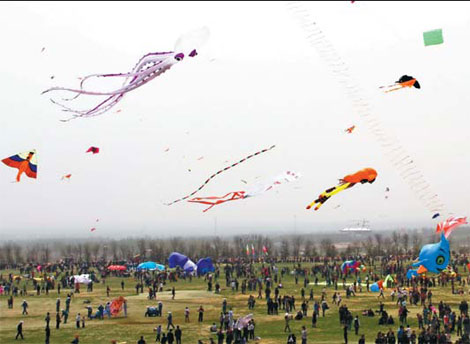Tips and Articles
Blowing in the wind
Updated: 2011-04-26 07:55
By Li Jing (China Daily)
After centuries of development, kite flying has become a popular sport in Europe.
"Kites are quite popular in France and all over the Europe," says Serge Allegre, a middle school teacher from Paris.
Allegre has been flying kites for 25 years and is also the founder and president of a kite association in Paris. He says people in Marseilles and in Mediterranean areas love the hobby with a passion.
"In France, there are four to five big kite festivals a year. In Dieppe, a city in Normandy, there is a big festival held every two years, which lasts for one week and has about 1 million participants," he says.
He says kite players in Europe prefer to make kites by themselves.
"Chinese kites are more traditional in forms, like swallows and fishes. In France, we make kites into stamps or the Eiffel Tower," he says.
Helmut C. Georgi, 59, a kite shop owner from Austria, says every year there are major kite festivals and exhibitions in Austria, where players come and show off their creations.
"The annual Vienna Kite Festival sees around 2,000 people and that is a big number for Austria," he says.
Georgi has been flying kites since he was 4 and today travels around the world to attend various kite competitions and festivals.
He says flying kites certainly gives him a lift. "Flying kites makes me relax," he says. "Besides, in international festivals, we meet friends all over the world and share the same hobby."
Meanwhile back in China, traditional kite makers fear their traditions will be lost.
"It is difficult to find inheritors for traditional kite making and the number of kite craftsman is decreasing," says Han Fuling, 79, deputy director of Kite Arts Commission in Shandong Arts & Crafts Association, and also a craftsman of traditional kites.
Han has been making kites for 72 years and his creations have won various prizes at many international competitions.
"To become a qualified kite craftsman, one has to master the skills of binding, pasting, drawing and flying, and each element takes a long time to master," Han says. "Nowadays young people are not willing to learn."
At the same time, some forward-looking export-oriented kite companies are developing new products, such as the "power kite" in an effort to boost the industry. Power kites originated in the United States and Europe in 1992 and can harness large wind forces, and are used in kite surfing, kite boarding, and kite skiing.
"We spent six years on research and development of a new power kite with 3D wind simulation technology," says Jie Bing, director of Albatross Stunt Kite Company in Shandong.
|
Participants from home and abroad enjoy flying kites in Weifang, Shandong province. |
The company is the only power kite maker in Weifang and all of its products are exported to Europe. In the past two years, its revenue has been growing by about 20 percent annually.
Jie says compared to traditional kites, power kites have a better market potential in Europe.
"A power kite is priced at 860 euros ($1,253) to 1,076 euros ($1,568), with a gross margin of more than 50 percent," he says. "Besides, power kites are easy to transport and have no specific requirements for weather or geographical conditions. They can be used for different sports activities," he says.
"Power kite sports are quite popular among the middle class in Europe. Many of them pack power kites and go kite surfing at the weekend."
Jie says the world kite industry is developing at a fast pace but Chinese kites have fallen behind the US and Europe in terms of design and technology.
"From paper and bamboo to nylon and carbon fiber, from traditional kites with a single line to power kites with two to four lines, the industry is experiencing fast development," he says. "But lack of advanced technology and limited product types have hindered the development of Chinese kites."
He says R&D is of great importance for domestic kite companies and they should keep pace with the latest industry trends and develop new models frequently.
Specials

Models gear up car sales
Beauty helps steer buyers as market accelerates.

Urban breathing space
City park at heart of industrial hub positions itself as top tourism attraction

On a roll
Auto hub Changchun also sets its sight on taking lead in railway sector
